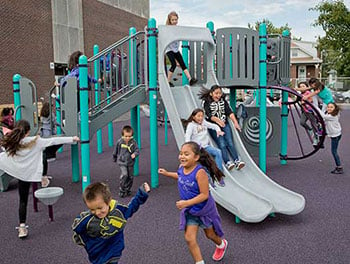School Playground Safety
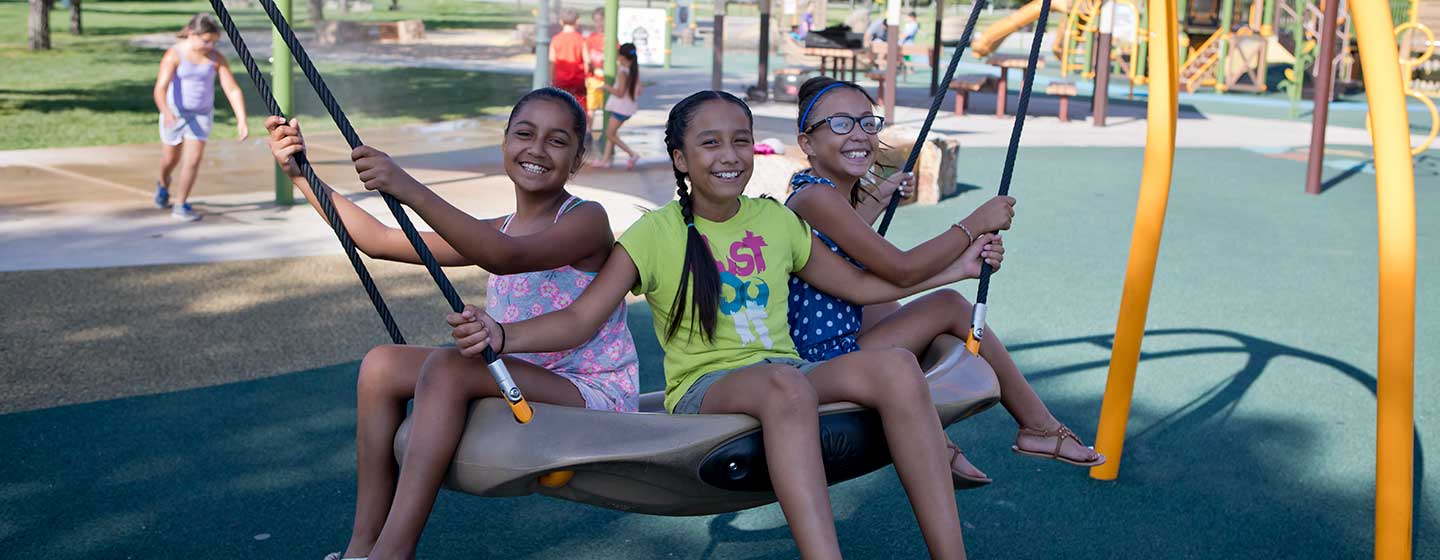
Keeping Playgrounds Safe
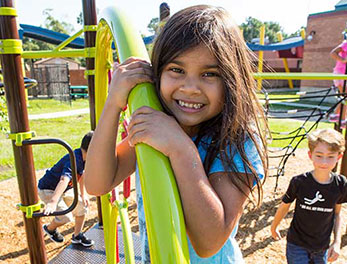 Kids will always find new and inventive ways to play on the playground equipment. While this exercise is great for the imagination, it may not be the best for their safety. Bumps, bruises and scraped shins will happen but it’s important to take steps to eliminate the risk of more serious injuries.
Kids will always find new and inventive ways to play on the playground equipment. While this exercise is great for the imagination, it may not be the best for their safety. Bumps, bruises and scraped shins will happen but it’s important to take steps to eliminate the risk of more serious injuries.
Many school and early childhood playground injuries can be prevented, but it takes effort by everyone involved with the playground—from the designer to the owner to the user of the play equipment. Through industry leading design engineering and quality materials, we emphasize safety and durability while creating innovative and fun environments.
With our age-appropriate products, safety surfacing and shade systems we can help you create your ideal playground that meets playground safety guidelines to keep kids safe.
Playground Safety Checklist
Consider these important safety factors when designing a playground:
- Age-appropriateness of sites and play equipment. The Consumer Products Safety Commission (CPSC) recommends separate play areas for kids ages 6 to 23 months, 2- to 5-year-olds and school-age children ages 5 to 12. Consider designing separate play areas to accommodate the different dimensions, skills and play styles of the age groups visiting your playground.
- Environmental conditions. The play area should be adequately shaded to protect against sun exposure, well-drained, visible from nearby paths, away from automobile and bicycle traffic, and separated from water or other natural hazards.
- Equipment design. Playground equipment should be structurally sound, durable and engineered with safety in mind. Work with a manufacturer like Landscape Structures who is known for its quality materials and innovative features.
- Layout of play area. Children’s play patterns can affect playground use. Your Landscape Structures playground consultant can help design an optimal layout to minimize congested play.
- Protective surfacing. This can be an adequate depth of a loose-fill material, wood fiber rubber mulch, factory-made resilient tiles, a unitary safety surface or a combination. One effective approach is to provide a loose-fill material for most of the use zones, with paths of poured-in-place or rubber tiles. This solution has the added benefit of making your (pre)school playground equipment accessible to children in wheelchairs and other mobility devices.
Safety Guidelines for Playground Equipment
We go the extra mile to establish and exceed the safety standards in our industry. From our exclusive compression clamps that keep fingers and clothing safe, to our tunnel slide design that eliminates pinched fingers, we use only the best materials and innovative features to ensure our products are not only safe but will last for generations.
When deciding on your early childhood or school playground equipment, insist your equipment conforms to the following regulations:
- The Consumer Product Safety Commission’s Handbook for Public Playground Safety
- The ASTM F1487 Standard Consumer Safety Performance Specification for Playground Equipment for Public Use, except sections 7.1.1, 10, 13.1.1, 13.1.2, 13.2, and 13.3; CAN/CSA Z614 Children's Playspaces and Equipment, except clauses 10 and 11; or both. Verify that equipment conforms to standards set by International Playground Equipment Manufacturer's Association (IPEMA) at ipema.org
- Accessibility requirements of ADA.
- Request documentation to ensure the protective surfacing around the equipment has been tested by a third party according to the ASTM F1292 Standard Specification for Impact Attenuation of Surfacing Materials within the Use Zone of Playground Equipment.
Playground Safety Regulations
Individual states or municipalities may have additional requirements so it’s important to check with the playground consultant in your region. Contact your Landscape Structures playground consultant to learn more about specific requirements in your area.
Proper Installation Keeps Playgrounds Safe
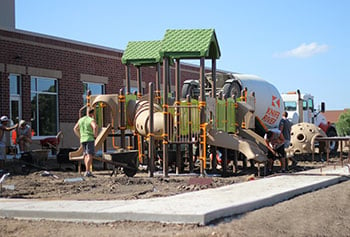 Site preparation and playground equipment installation can either be handled by certified professionals or your school or early childhood facility can recruit volunteers. A community build project not only saves costs but can foster relationships within the community and create a sense of pride and ownership in the new play space. To ensure a safe installation with your community build, make sure the following conditions are met:
Site preparation and playground equipment installation can either be handled by certified professionals or your school or early childhood facility can recruit volunteers. A community build project not only saves costs but can foster relationships within the community and create a sense of pride and ownership in the new play space. To ensure a safe installation with your community build, make sure the following conditions are met:
- The manufacturer provides detailed instructions on how to install the equipment. This should be in the form of a manual that has been customized for your specific equipment.
- Your volunteer crews are well-organized. Our Guide to Community Build Playgrounds outlines everything including how to recruit and organize the volunteers, gather necessary tools and build a schedule to help execute the installation.
- Your installation is supervised by a manufacturer-certified installer.
Request the Guide to Community Build Playgrounds to learn more about community build projects and how to ensure proper and safe installation.
Inspections and Maintenance are Key to Safe Playgrounds
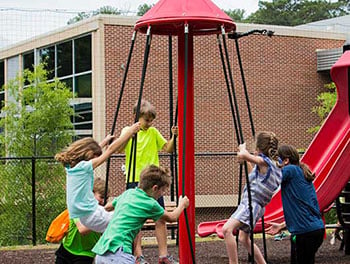 Playground safety may start with design but even the best-designed playgrounds can present hazards if equipment is incorrectly installed, broken, physically worn, damaged by vandals or weakened by the ravages of time. This is why a safety audit and regularly scheduled preventative maintenance inspections are a necessary part of every playground’s safety program.
Playground safety may start with design but even the best-designed playgrounds can present hazards if equipment is incorrectly installed, broken, physically worn, damaged by vandals or weakened by the ravages of time. This is why a safety audit and regularly scheduled preventative maintenance inspections are a necessary part of every playground’s safety program.
Safety audits
A playground safety audit is a one-time process that focuses on compliance with the current standard of care. Whenever possible, such audits should be performed by a staff member or outside consultant who has completed the National Playground Safety Institute’s Certified Playground Safety Inspector (CPSI) training.
Maintenance inspections
Maintenance inspections are conducted at regular intervals and focus on immediate hazards caused by aging or damaged equipment—e.g., worn swing hangers or missing fasteners. A maintenance checklist shouldn’t merely say “check swing hanger for excessive wear.” Instead, it should say: “Replace swing hanger when worn to 50 percent of original diameter.”
We will help you develop a maintenance program for your school or early childhood playground components and play events. Every Smart Play®, Weevos®, Evos®, PlayBooster®, PlayShaper® or Hedra® system is delivered with a customized maintenance guide. Illustrated sheets provide step-by-step instructions on how to inspect each component. And an accompanying “Guide to the Frequency of Inspections” helps you weigh the various factors involved in devising a maintenance schedule.
Striking a Balance Between Safety and Challenge in Playground Design
Playgrounds are a place where children can learn and grow through exploration and social interaction. Age- and developmentally appropriate challenges are key to that development. Playgrounds should ideally offer age-appropriate challenges and a safe environment all in one.
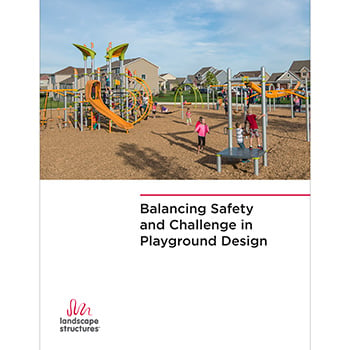
Parental concern along with standards that have decreased design freedom are contributors to the lack of challenging opportunities in today’s play equipment. Well-designed playgrounds keep kids away from hazards while encouraging them to test their limits and learn to overcome challenges.
To learn more about how to create a playground environment that is both challenging and safe, download our whitepaper, “Balancing Safety and Challenge in Playground Design”.
Creating Safe Playgrounds for Children of All Ages
To minimize risk and provide children of all ages with a safer, more satisfying play experience, be sure to consider age-appropriate equipment. One of the biggest challenges in designing a playground is creating safe, developmentally appropriate play experiences for children of different ages. School playgrounds for children ages 5- to 12-years should feature different play elements than early childhood playgrounds age 2- to 5-year-olds.
Super Safety Team to the Rescue
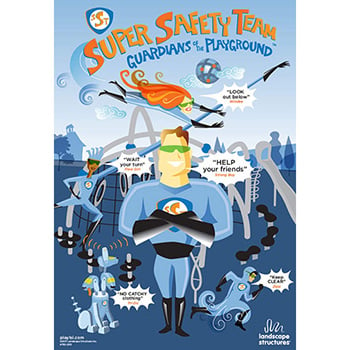
We offer a playground safety program to help teach early childhood and elementary school students the importance of safe play. The program, featuring the Super Safety Team, Guardians of the Playground, contains practical tools for schools and childcare organizations.
Contact your playground consultant to learn more about this safety program.
Playground Safety Experts from the Beginning
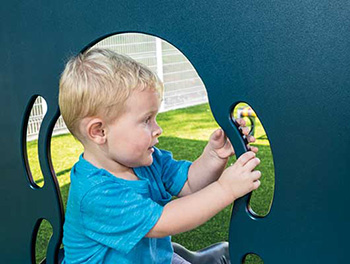 We have a long history of involvement in playground safety. For 20 years, Steve King, our co-founder, was chairman of a task group of the American Society for Testing and Materials (ASTM) that worked with the Consumer Product Safety Commission (CPSC) to update the safety and accessibility standards for public playgrounds. Steve was also past President of International Play Equipment Manufacturers Association (IPEMA) that works to educate the industry on playground safety. In addition, Randy Watermiller, our vice president of product development, is now heavily involved in both organizations.
We have a long history of involvement in playground safety. For 20 years, Steve King, our co-founder, was chairman of a task group of the American Society for Testing and Materials (ASTM) that worked with the Consumer Product Safety Commission (CPSC) to update the safety and accessibility standards for public playgrounds. Steve was also past President of International Play Equipment Manufacturers Association (IPEMA) that works to educate the industry on playground safety. In addition, Randy Watermiller, our vice president of product development, is now heavily involved in both organizations.
For help in safer early childhood playground designs, or for free resource materials that can help in your planning, contact your local Landscape Structures consultant.
